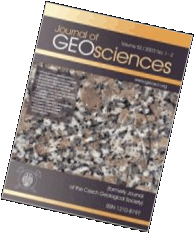 Export to Mendeley
Export to MendeleyOriginal Paper
The role of hydrogen in tellurites: crystal structure refinements of juabite, poughite and rodalquilarite
Journal of Geosciences, volume 56 (2011), issue 3, 235 - 247
DOI: http://doi.org/10.3190/jgeosci.093
The crystal structures of the tellurite minerals juabite, CaCu10(Te4+O3)4(AsO4)4(OH)2(H2O)4, poughite, Fe3+2(Te4+O3)2(SO4)(H2O)2·H2O and rodalquilarite, Fe3+2(Te4+O2OH)3(Te4+O3)Cl, have been refined to R1 (Fo > 4sF) = 2.36%, 2.38% and 1.84%, respectively. The determination of H atom positions in all three structures has allowed the elucidation of the hydrogen bonding schemes and detailed bond-valence analyses. These are the only tellurite mineral structures for which H atom positions have been determined. The structures of all contain one-sided Te4+ coordinations as Te4+O3 pyramids with additional anions at greater distances. The one-sided coordinations are attributable to the stereochemically active 6s2 lone-electron-pair of the Te4+. The overall linkage schemes in these structures are quite different, yet all can be considered layer structures in which relatively weak long Te-O and/or Te-Cl bonds are involved in the linkages between layers. In juabite, a long apical Cu-O bond participates in the linkage between layers and, in poughite and rodalquilarite, hydrogen bonding also links the layers.
Webdesign inspired by aTeo. Hosted at the server of the Institute of Petrology and Structural Geology, Charles University, Prague.
ISSN: 1803-1943 (online), 1802-6222 (print)
email: jgeosci(at)jgeosci.org


IF (WoS, 2024): 1.3
5 YEAR IF (WoS, 2024): 1.4
Policy: Open Access
ISSN: 1802-6222
E-ISSN: 1803-1943